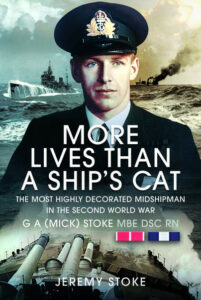MORE LIVES THAN A SHIP’S CAT: THE MOST HIGHLY DECORATED MIDSHIPMAN IN THE SECOND WORLD WAR, G A (MICK) STOKE MBE DSC RN
This might look like one of those ‘self-published family saga’ books. It isn’t, however, it could have done with proof-reading by someone with a bit of naval knowledge. Pen & Sword should, I assume have done this, but … The Dramatis Personae is incomplete, a few of the Naval Abbreviations & Slang are wrong[1]and the photo of a KGV class battleship is labelled as “A destroyer on the Russian convoys in bad weather”.
Criticisms over; I really enjoyed this book, but to get the most out of it, Members will need a reasonable knowledge of WWII naval history. Paymaster Stoke was clearly an exceptional individual – Appendix C contains extracts of all his S206s & Flimsies[2] (although several do note his lack of tact) – and his Daily Telegraph obituary[3] notes “he became managing director & then chairman of a variety of companies…..from food to electronics and financial services….and a non-executive director of the Bank of England”. The meat of this book is Stoke’s letters home & they provide a vivid view of the naval war as seen by a junior officer. RoPs,[4] other letters & published memoirs and Admiralty documents from the records at Kew provide the remainder.
Stoke volunteered in September 1939 & joined Dartmouth in January 1940 as part of the 50th Special Entry.[5] His pay as a Cadet was 4/- a day.[6] After 4 months, he left BRNC with a first & joined HMS Glasgow to complete his basic training. In late 1940 in the Med, Glasgow was torpedoed twice (four premature explosions/no damage first time – two hits second time). As she needed significant repairs, the Captain (H Hickling) was appointed as SNO Inshore Squadron & took Mid Stoke as his one & only staff officer. For the next six months, he served along the N African coast, ending up in Tobruk under siege from Rommel’s Afrika Korps. He was Mentioned in Dispatches for several acts of bravery whilst rescuing survivors from various burning & sinking ships in Tobruk and then received the Distinguished Service Cross for exemplary gallantry in minimising damage from a burning ammo dump, shortly after which he was sent back to Alexandria with exhaustion.[7]
His next appointment was to HMS Queen Elizabeth, Admiral Cunningham (CinC Med)’s flagship. They were ahead of HMS Barhamwhen she was torpedoed & spectacularly blew up, Queen Elizabeth had been U-331’s original target. His very active war continued, as he was still serving in Queen Elizabeth on 18th Dec 1941, when the Italian Navy’s chariots[8] managed to drop their warheads beneath her, so putting her out of service for about a year. Ten days later, Mid Stoke was appointed to HMS Carlisle, an AA cruiser, where his time included several Malta convoys, significant bomb damage, a two day heavily-blitzed stay in Malta & the Second Battle of Sirte.[9]
In April 1942, Carlisle returned to the UK for a refit & Mid Stoke left her for some leave (his first home leave in over 2 years) & Paymaster Sub-Lieutenant’s exams (he got a first). He also met a Third Officer WRNS, who was to become his wife & was appointed to the staff for Operation Torch, the invasion of N Africa. His MBE was awarded for “bravery during an air attack in N African waters”. With his experience, it is no surprise that he continued on the staff for the invasions of Sicily & then the Italian Mainland. After Salerno,[10] Acting Paymaster Lieutenant (he had been awarded advanced promotion for ‘Meritorious War Service’) Stoke MBE DSC was sent to HMS Hardy (sunk in Russian convoy JW56), then onto HMS Kempenfelt (Secretary to Capt(D)) where he was (as a pusser…) given command of one of the upper deck gun mountings off the Canadian beach (Juno) on D-Day. His final wartime appointment was Supply Officer of HMS Rajah, an escort carrier ferrying aircraft around the Pacific.
As I said at the beginning, I really enjoyed reading this book. So many WWII memoirs are written by those in command. This is written about and mainly (from his letters) by, a junior officer, who had a remarkable war and was very closely involved with those in command, but recorded his thought (including on his bosses) and feelings at the time. Strongly recommended.
ANDREW WELCH
[1] A couple of examples – FO is listed as Flag Officer (Vice Admiral and above) & RNAS is used when RAN is meant.
[2] S206 was the RN Officer’s Reporting Form, of which one was supposed to be told the contents, but sometimes received a ‘sanitised’ version. The S206 was dispatched to one’s Appointer (aka Career Manager these days. The Flimsy was an ‘extract’ of the S206 which every officer was given to keep by their COs.
[3] Written by John Winton.
[4] Reports of Proceedings.
[5] The Special Entry was aimed at those (mainly public school boys) joining at 18. Prince Philip was in the 49th Special Entry.
[6] When I joined in 1968 it was 6/8ͩ. According to the web it is now £79.30/day!
[7] Then awarded to officers below the rank of Commander for ‘exemplary gallantry during active operations’.
[8] Chariots were also called human torpedoes. At Churchill’s urging, the RN followed the Italian Navy’s example and RN chariots were subsequently used against both German & Italian targets.
[9] 22nd March 1942. The convoy escort of 4 light cruisers, 1 AA cruiser (Carlisle) & 17 escorts held off an Italian force of 1 battleship, 2 heavy cruisers, 1 light cruiser & 10 escorts. Under the between the wars ‘naval disarmament’ treaties, heavy cruisers had 8” guns & light 6”.
[10] The landings on the Italian coast S of Naples on 9th Sept 1943.


